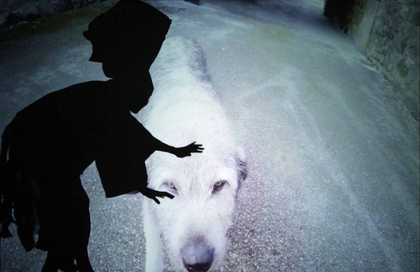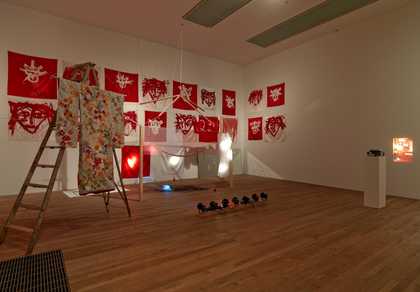In a complex process of layering and fragmentation, Joan Jonas’s work combines a range of different media, including objects or ‘props’: masks, cones and mirrors, found and created images, projected film and video, texts, sounds, and sampled and live music. She borrows from diverse cultural sources, including myths, folk tales, epic poems and protest songs, sampling and reworking this material to create fresh narratives, finding new meanings that address contemporary issues such as alienation and climate change.
Jonas has been a key figure in the international art world for five decades and continues to influence younger generations of artists today. Ahead of her exhibition at Tate Modern this spring, Tate Etc. met up with Jonas in her New York studio, together with Rachel Rose, an artist in Tate's collection working at the forefront of contemporary video.
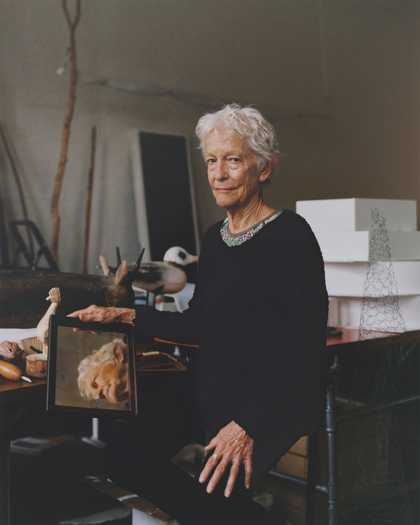
Joan Jonas in her New York studio, photographed by Toby Coulson for Tate Etc., September 2017
© Toby Coulson 2018
RACHEL ROSE How did you first get into performing?
JOAN JONAS I studied art history, sculpture and drawing at Columbia graduate school in New York, then worked in galleries for a while – for Richard Bellamy at the Green Gallery in particular, then, later, at Dwan Gallery, where I became acquainted with the work of many contemporary artists, such as Lucas Samaras, Donald Judd, Lee Lozano, Walter de Maria, Michael Heizer and Agnes Martin.
I wasn’t satisfied with my own work in sculpture at the time and began to see collaborations between visual artists and dancers, which intrigued me. I remember watching a performance by Claes Oldenburg in a storefront on the Lower East Side: the audience moved from room to room, viewing a different scene in each one, all involving elaborate props and costumes and strange, repeated dialogues. I was immediately attracted to the possibilities of working with performance as a visual artist.
I had many varied influences at that time. I was inspired by the music of composers La Monte Young, Steve Reich and Philip Glass. I also travelled to Greece where I saw early Greek and Minoan art and imagery, and became interested in some of the female characters in Minoan culture – I identified with some of them and they became part of my thinking. After a year, I returned to New York where dancers such as Deborah Hay, Trisha Brown, Yvonne Rainer, Meredith Monk and Lucinda Childs were all giving workshops, and I participated in these to make the transition from sculpture to live action. To step into the space of performance required research into what had been done already – in music, dance and happenings. I wanted to develop my own language.
All through the 1960s, friends would call and tell me about happenings, music, performances and shows of paintings and sculpture. The scene was relatively small, but we all knew one another and went to each other’s events. I was close to Richard Serra, Robert Smithson and Nancy Holt and it was artists like these, along with dancers, musicians, composers and curators that made up my audience in the late 1960s and early 1970s.

Photograph by Richard Serra for an unrealised poster of Organic Honey's Visual Telepathy 1972
© ARS, NY and DACS, London 2018
RR How did you begin working with video – was it through film at first?
JJ As long as I can remember, I’ve been absorbing the magic, beauty and language of film simply by attending screenings. And by exploring film history through the Anthology Film Archives here in New York, looking at early Japanese, French and German films. When I began making art, I didn’t see major differences between a poem, a film, a sculpture or a dance. I related and combined ideas of structure and narrative, applying the language of film to my videos and performances – techniques such as montage, the cut, the pan, the zoom, superimpo- sition and so on.
With my first video camera, I experimented with creating a closed-circuit set-up of camera-monitor-projector, where I could see myself reflected as a subject. That inspired me to perform for the camera, working with masks, costumes and objects to create alternative personas, and to question the terms of the female/androgynous persona. I called my alter ego ‘Organic Honey’ and one of my earliest works of this kind was called Organic Honey’s Visual Telepathy 1972.
Video has been a major factor in my performances. I would incorporate a camera to transmit a live video image – a close-up of objects, a figure, performed actions – to a monitor or a projection. The audience simultaneously saw the live action with a close-up or a detail of the poetic narrative. I began to work with this layering device, developing it over the years.
RR What aspects of film have you consciously returned to the most over the years?
JJ I have always been interested in how a cut or a process of layering, holding one image up against another, can be jarring for the audience as it establishes meaning. I learned about these techniques simply by looking at films at Anthology, noticing at the time, in particular, Georges Franju and Sergei Eisenstein. However, my study of art history and early Renaissance painting had just as much influence on the way I considered the frame and the illusion of depth.
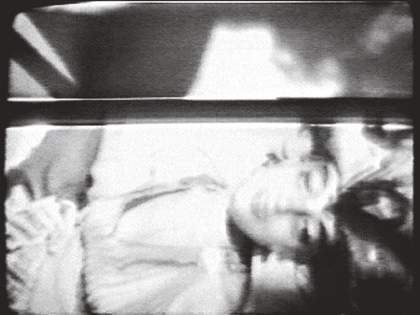
Video stills from Joan Jonas's Vertical Roll 1972
© ARS, NY and DACS, London 2018
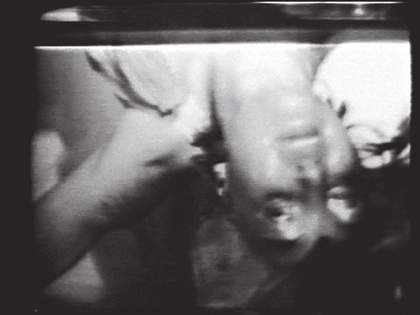
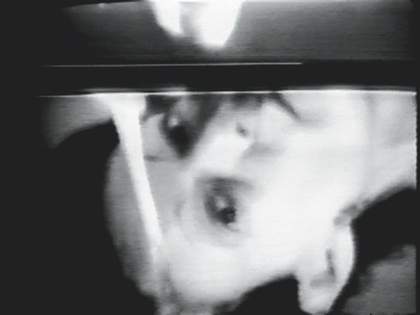
RR How did you expand your work away from the editing and the framing inherent to narrative film?
JJ Early filmmaking came partly out of theatre and, of course, video followed film. When I worked with video, I always referred to film and the idea of film. I also worked with the peculiarities of video compared to film – like my work Vertical Roll 1972, a single-channel work in which the vertical roll was filmed off a monitor and refers to frames in a film. It was made in Robert Irwin’s light-filled studio in Venice, California. The camerawoman, Roberta Neiman, transmitted my performance via the camera to the monitor with the ‘vertical roll’ effect, a glitch in the monitor causing each frame to slide off the screen, punctuating my actions. I thought of the ‘vertical roll’ as frames in a film going by.
So I was very consciously playing with comparisons between the two mediums. I also liked the very grainy quality of video, and the ways you could manipulate the image so easily with the twist of a lens, but the most radical thing – for me – was that artists could sit in front of the camera and see themselves. That was a huge moment.
RR A huge moment in terms of the work being essayistic or biographical – or something else?
JJ In terms of the immediate feedback. In film you can film yourself, or someone else, but one still has to go through a studio in order to develop the footage. With video, you can produce everything in your own loft or studio. You could perform by yourself for the camera and see what you were working with right away.

Joan Jonas in her New York studio, photographed by Toby Coulson for Tate Etc., September 2017
© Toby Coulson 2018
RR What are your feelings about making a feature?
JJ I’ve often thought of making a longer, narrative film that could be shown in cinemas. But when I began making art, one of the models for my form and structure was poetry. My work has always had a poetic structure, which doesn’t lend itself to an extended narrative. I have worked with the text of epic poems, however, such as Sweeney Astray, an early Irish epic poem translated by Seamus Heaney, and Laxdœla Saga, an Icelandic saga. I collect paragraphs and fragments that, to me, contain the essence of the work, and often make a script, which inspires, not an illustration of the text, but a parallel visual representation. I use extracts, without ever changing the language. I arrange fragments and interpret them in my own way, visually.
RR Ritual and magic are central to the Laxdœla Saga and to Sweeney Astray – as if the texts you choose are inherently expressing through stories the themes that you work with formally...
JJ Well, studying art history and literature, and looking at the beginnings of art, I came to understand that art comes from ritual. In 1970 I went to Japan and saw the Noh Theatre. The movements were so slow and precise, always in direct communication with the audience in a kind of shared experience. When I began to do performance, I thought, Why am I doing this and who is it for? I began to think of it as a contemporary ritual.
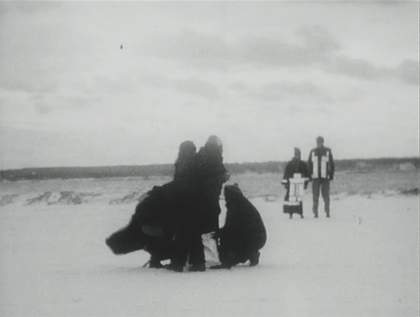
Video still from Joan Jonas's Wind 1968
© ARS, NY and DACS, London 2018
In the 1960s, I went to Arizona to see a [native American] Hopi dance. Seeing the snake dance was an amazing experience. After that, I had never wanted to represent this experience in any way in my work, because it’s a Hopi ritual. However, I thought I could approach it through the German art historian Aby Warburg and his book, Mnemosyne Atlas, about his trip to the American Southwest. I liked Warburg’s fascination with different cultures and was also interested in his method of looking at art history. This was also my method somehow – using and mixing these different disciplines and historical times. He didn’t look at art history in a linear way, but in a cross-cultural way. He found images from all these different sources that echoed one another and made his atlas, which was a collection of these images. I found that very compelling.
Although I thought of my work as a kind of everyday ritual, I wanted to bring something more into it. The dancers that I knew at the time, like Steve Paxton, were experimenting with everyday movement, and that allowed me to step into performance without feeling that I needed formal training in dance. That was an important entry for me.
All those things come together in a work like Wind 1968, with its mirror costumes and cloaked figures. It looks a little bit like a ritual in Siberia, as somebody once described it.
RR This reminds me of Borges’s story ‘Garden of Forking Paths’, which I know was influential for you. Times coexist here – the mirror seems like a prop or method for you to express that.
JJ The mirror was my first prop. It had a visual impact, altering space by fracturing it and changing the audience’s perception of that space. I was particularly interested in the fact that mirrors make people uncomfortable. Audience members see themselves in the mirror as they pass by. Visual perception was, in a very concrete way, a part of my concern. I would think, How can I affect the way the audience sees? By altering the image, one affects how the audience feels.
RR Let’s talk about sound.
JJ I’ve always developed my own soundtracks. These were comparatively simple in the beginning, becoming gradually more and more layered as time went on. I sang folk songs in my work and included fragments of music, such as reggae. Early sounds were made by hitting stones together, or blocks of wood, as in my outdoor work [Jones Beach Piece 1970 and Delay Delay 1972] to demonstrate the presence of the sound delay that occurs when the source is in the distance and there is a delay between the action and the sound reaching the audience. De-synchronisation is another one of my devices.
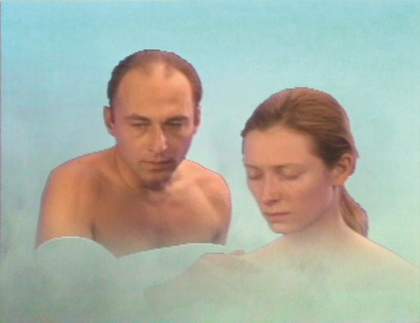
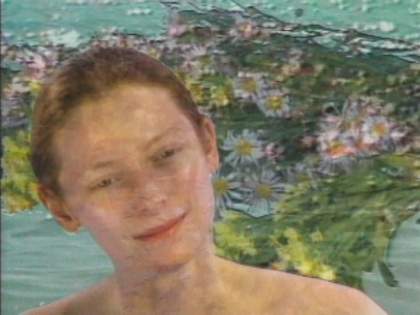
Video stills from Joan Jonas's Volcano Saga 1989
© ARS, NY and DACS, London 2018
In The Juniper Tree 1976, I wanted to make a soundtrack, like a film soundtrack, to suggest moods and dynamics. I made the whole thing myself with a reel-to- reel recorder, cutting and splicing. Later, working with composers such as Alvin Lucier and Alvin Curran, I began to combine my soundtracks with original music. Lucier composed the music for Volcano Saga 1989; Curran wrote the soundtrack for Variations on a Scene 1990. Since 2004, I have been working with Jason Moran, who composes and plays live in my performances. He has worked on The Shape The Scent The Feel of Things 2004, Reading Dante 2008, Reanimation 2014, and They Come to Us Without a Word II 2015. This has been my longest collaboration with a composer and musician, and has inspired my movement and sound-making in a more dynamic way. Jason’s approach as a jazz musician means that, while playing the same music we’ve basically decided upon for the performance, he embellishes and invents different ways of playing it each time. This animates me. We are both improvisers.
RR One of your collaborations with Moran, Reanimation, was inspired by Halldór Laxness’s book Under the Glacier. Why this book, then?
JJ I did a piece in 1989 called Volcano Saga, based on Laxdœla Saga. While I was doing research for that, I read all the translated sagas I could find. I became totally fascinated with the Icelandic people’s relation to their own literature. They talk about the characters in the sagas like they know them, as if they live down the road. And then, while I was there, I just found Halldór Laxness in the bookstores. I read a few of his books and really liked him, because I was totally immersed in Icelandic lore, and their superstitions and folk tales are interesting to me. Under the Glacier just stayed with me. Sometimes things haunt you.
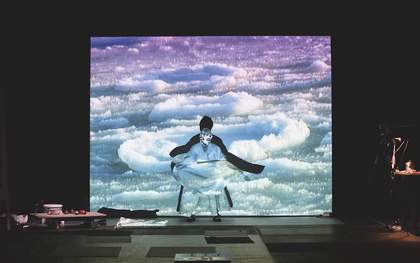
Joan Jonas performing Reanimation at Pirelli HangarBicocca, Milan, 2012, photograph by Moira Ricci
© ARS, NY and DACS, London 2018
RR This sublime state of being lost in a landscape, a loosening of separation between inside and outside, feels like a central principle to your work, and the book has this explicitly – the narrator lost in the kaleidoscopic glacier.
JJ Yes, it does. What else interests me, which I didn’t include, was all the dialogue, some of which is very witty and funny. Everything is very tongue-in-cheek, and so anti-establishment. It’s so secular. But it’s also mystical, so it has all these different levels. For me, the landscape in Iceland is so bizarre, so special, unusual and primal that it becomes a kind of character in everything.
RR You’re attracted, repeatedly it seems, to these ethereal, inhuman landscapes, which you film very personally, often with a handheld camera.
JJ I look through the camera. I do want it to be personal. That’s what I have – that’s my handwriting, you could say. So I try to indicate my presence – through a kind of movement. I’m trying to get the spirit of the place, and I can’t put that into words.
I have to trust my own feelings. How do I create a place with sound, image? How do I bring those things together to draw the audience in to really... simply tell the story. How do you do that? I don’t have a profound answer... I just have to keep going into the material and improvising with it, working with it over and over again, until I feel that I have found something.
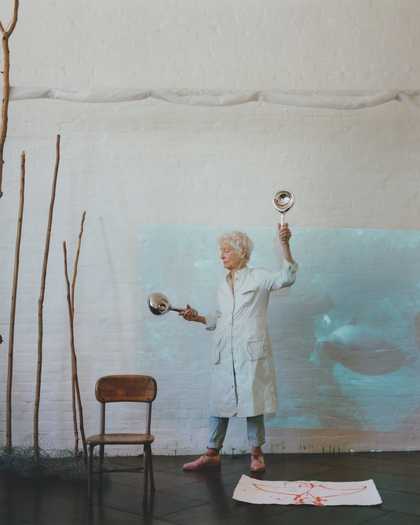
Joan Jonas in her New York studio, photographed by Toby Coulson for Tate Etc., September 2017
© Toby Coulson 2018
Joan Jonas, Tate Modern, 14 March – 5 August, curated in close collaboration with the artist by Andrea Lissoni, Senior Curator, International Art (Film), Tate Modern and Julienne Lorz, Curator, Haus der Kunst, Munich with Monika Bayer-Wermuth, Assistant Curator, Tate Modern. The exhibition tours to Haus der Kunst, Munich in autumn. Joan Jonas will also perform live alongside other artists as part of the BMW Tate Live Exhibition: Ten Days Six Nights programme, Tate Modern, 16 – 25 March.
Joan Jonas and Rachel Rose are both artists who live and work in New York. Joan Jonas was photographed in her New York studio by Toby Coulson for Tate Etc., September 2017.

